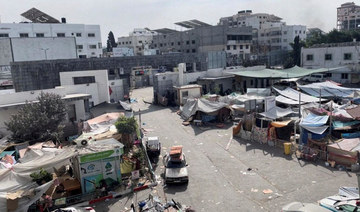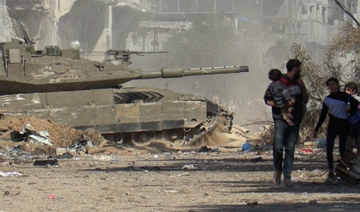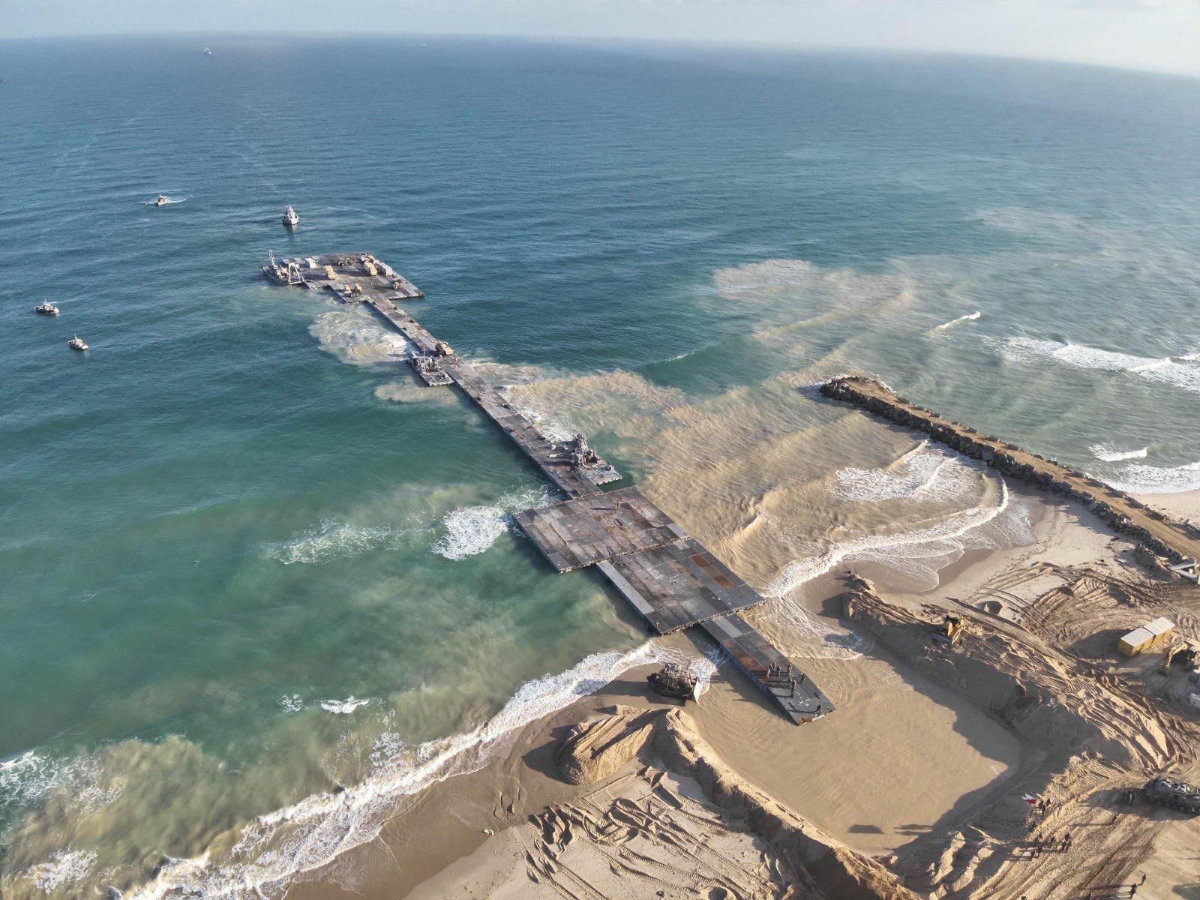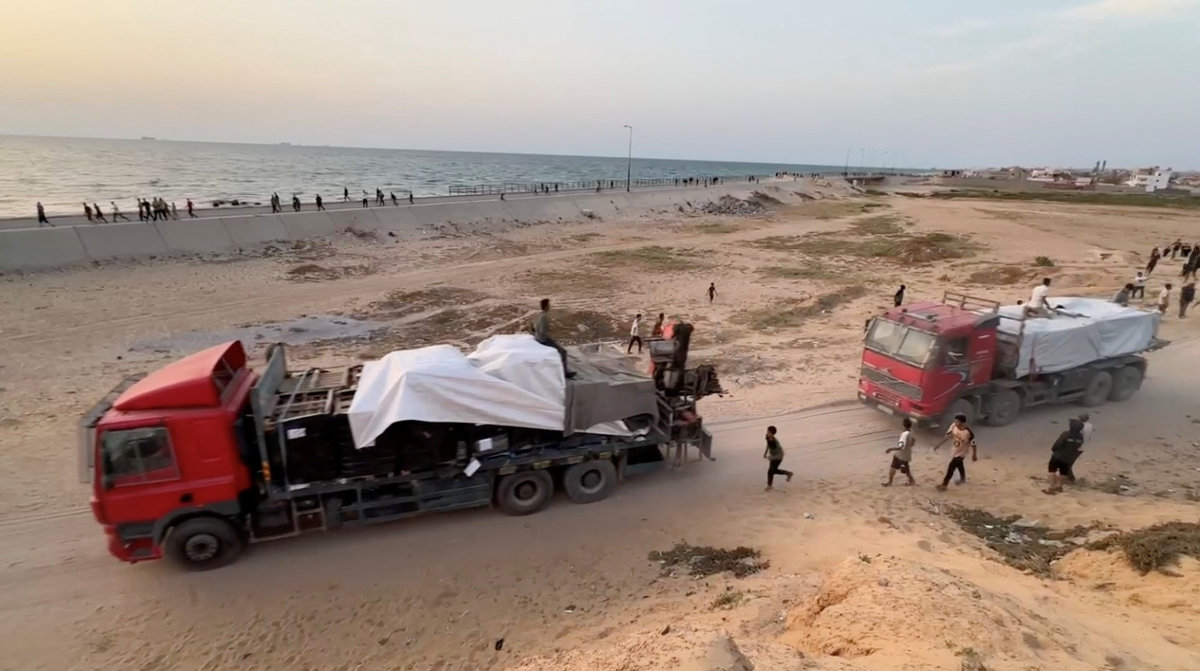KHAN YOUNIS, Gaza Strip: Health officials said 31 premature babies in “extremely critical condition” were transferred safely Sunday from Gaza’s main hospital and will go to Egypt, while over 250 patients with severely infected wounds and other urgent conditions remained stranded days after Israeli forces entered the compound to look for Hamas operations there.
The newborns from Shifa Hospital, where power was cut and supplies ran out while Israeli forces battled Palestinian militants outside, were receiving urgent care in the southern Gaza city of Rafah. They had dehydration, hypothermia and sepsis in some cases, said Mohamed Zaqout, director of Gaza hospitals. Four other babies died in the two days before the evacuation, he said.
A World Health Organization team that visited Shifa for an hour Saturday said hospital corridors were filled with medical and solid waste, increasing the risk of infection for patients who were “terrified for their safety and health, and pleaded for evacuation.” Twenty-five staff stayed behind.
The UN agency said the vast majority of patients had amputations or burns, and many wounds were severely infected, with antibiotics unavailable. Missions were being planned to evacuate the remaining people to southern Gaza in the next 24-72 hours, “pending guarantees of safe passage,” the WHO said.
Later Sunday, Israel’s army said it had strong evidence supporting its claims that Hamas maintains a sprawling command post inside and under Shifa. Israel has portrayed the hospital as a key target in its war to end Hamas’ rule in Gaza following the militant group’s wide-ranging attack into southern Israel six weeks ago.
The army said it found a 55-meter (60-yard) tunnel about 10 meters under the hospital’s 20-acre complex, which includes several buildings, garages and a plaza. It said the tunnel included a staircase, blast-proof door and a firing hole that could be used by snipers.
The Associated Press couldn’t independently verify Israel’s findings, which also included a pair of security camera videos showing what the military said were two foreign hostages, one Thai and one Nepalese, taken to the hospital following the Oct. 7 attack.
The army also said an independent medical report had determined that a female Israeli soldier, Cpl. Noa Marciano, whose body was recovered in Gaza last week, had been killed by Hamas inside the hospital.
Hamas and hospital staff earlier denied the allegations of a command post under Shifa. Critics describe the hospital as a symbol of what they call Israel’s reckless endangerment of civilians. Thousands in Gaza have been killed in Israeli strikes, and there are severe shortages of food, water, medicine and fuel in the besieged territory.
Senior Hamas official Osama Hamdan dismissed the Israeli military’s announcement and didn’t deny that Gaza has hundreds of kilometers of tunnels. However, he said, “the Israelis said there was a command and control center, which means that the matter is greater than just a tunnel.”
SHIP SEIZED
Israel’s military said Yemen-based Houthi rebels had seized a cargo ship in the southern Red Sea sailing from Turkiye to India but said no Israelis were aboard and that it wasn’t an Israeli ship.
The Houthis said they had seized an Israeli ship and crew and took the vessel to the Yemeni coast but gave no details, other than to say it was treating the captives “in accordance with the teaching and values of our Islamic religion.” The Iranian-backed group had threatened to target Israel-linked vessels in the Red Sea.
Israeli Prime Minister Benjamin Netanyahu’s office blamed the Houthis for the attack on the Bahamas-flagged Galaxy Leader, a vehicle carrier affiliated with an Israeli billionaire.
HEAVY FIGHTING IN THE NORTH
Heavy clashes were reported in the built-up Jabaliya refugee camp in northern Gaza. “There was the constant sound of gunfire and tank shelling,” Yassin Sharif, who is sheltering in a UN-run hospital there, said by phone.
The commissioner-general of the UN agency for Palestinian refugees, Philippe Lazzarini, said 24 people were killed the day before in what witnesses described as an Israeli airstrike on a school in a crowded UN shelter in Jabaliya. The Israeli military, which has repeatedly called on Palestinians to leave northern Gaza, said only that its troops were active in the area “with the aim of hitting terrorists.”
“This war is having a staggering and unacceptable number of civilian casualties, including women and children, every day. This must stop,” UN Secretary-General Antonio Guterres said in a statement on that strike and another on a UN-run school within 24 hours.
More than 11,500 Palestinians have been killed, according to Palestinian health authorities. A further 2,700 have been reported missing, believed buried in rubble. The count does not differentiate between civilians and combatants; Israel says it has killed thousands of militants.
HOSTAGE NEGOTIATIONS
About 1,200 people have been killed on the Israeli side, mainly civilians killed during the Oct. 7 attack, in which Hamas dragged some 240 captives back into Gaza and shattered Israel’s sense of security. The military says 63 Israeli soldiers have been killed, including 12 over the past 24 hours.
Hamas has released four hostages, Israel has rescued one, and the bodies of two were found near Shifa where there had been heavy fighting.
Israel, the United States and the Arabian Gulf nation of Qatar, which mediates with Hamas, have been negotiating a hostage release for weeks. “We are hopeful that we can get a significant number of hostages freed in the coming days,” Israel’s ambassador to the US, Michael Herzog, told ABC’s “This Week.” He added, “We’re talking about a pause in the fighting for a few days, so we can get the hostages out.”
Qatar’s prime minister, Sheikh Mohammed bin Abdulrahman Al Thani, said Sunday the “the sticking points, honestly, at this stage are more practical, logistical.”
WINTER ARRIVING
More than two-thirds of Gaza’s population of 2.3 million have fled their homes. The UN agency for Palestinian refugees, or UNRWA, is struggling to provide basic services to hundreds of thousands of displaced people. Seventeen of its facilities have been directly hit, the agency said.
Their misery has worsened in recent days with the arrival of winter, with cold winds and driving rain.
Over the weekend, Israel allowed UNRWA to import enough fuel to continue humanitarian operations for another couple of days, and to keep Internet and telephone systems running. Israel cut off all fuel imports at the start of the war, causing Gaza’s sole power plant and most water treatment systems to shut down.
Defense Minister Yoav Gallant on Saturday gave the clearest indication yet that the military plans to expand its offensive to the south, where Israel has told Palestinian civilians to seek refuge. Israel has repeatedly struck what it says are militant targets across the south, often killing civilians.
The evacuation zone is already crammed with displaced civilians, and it was not clear where they would go if the offensive moved closer. Egypt has refused to accept any influx of Palestinian refugees, in part because of fears that Israel would not allow them to return.
Palestinian-Canadian Khalil Manaa, 71, left Gaza for Egypt on Sunday. After fleeing to southern Gaza, he said he and relatives shared a crammed home of 40 people. “And there, we also were subjected to intense strikes. … A rocket hit our house,” he said.



























